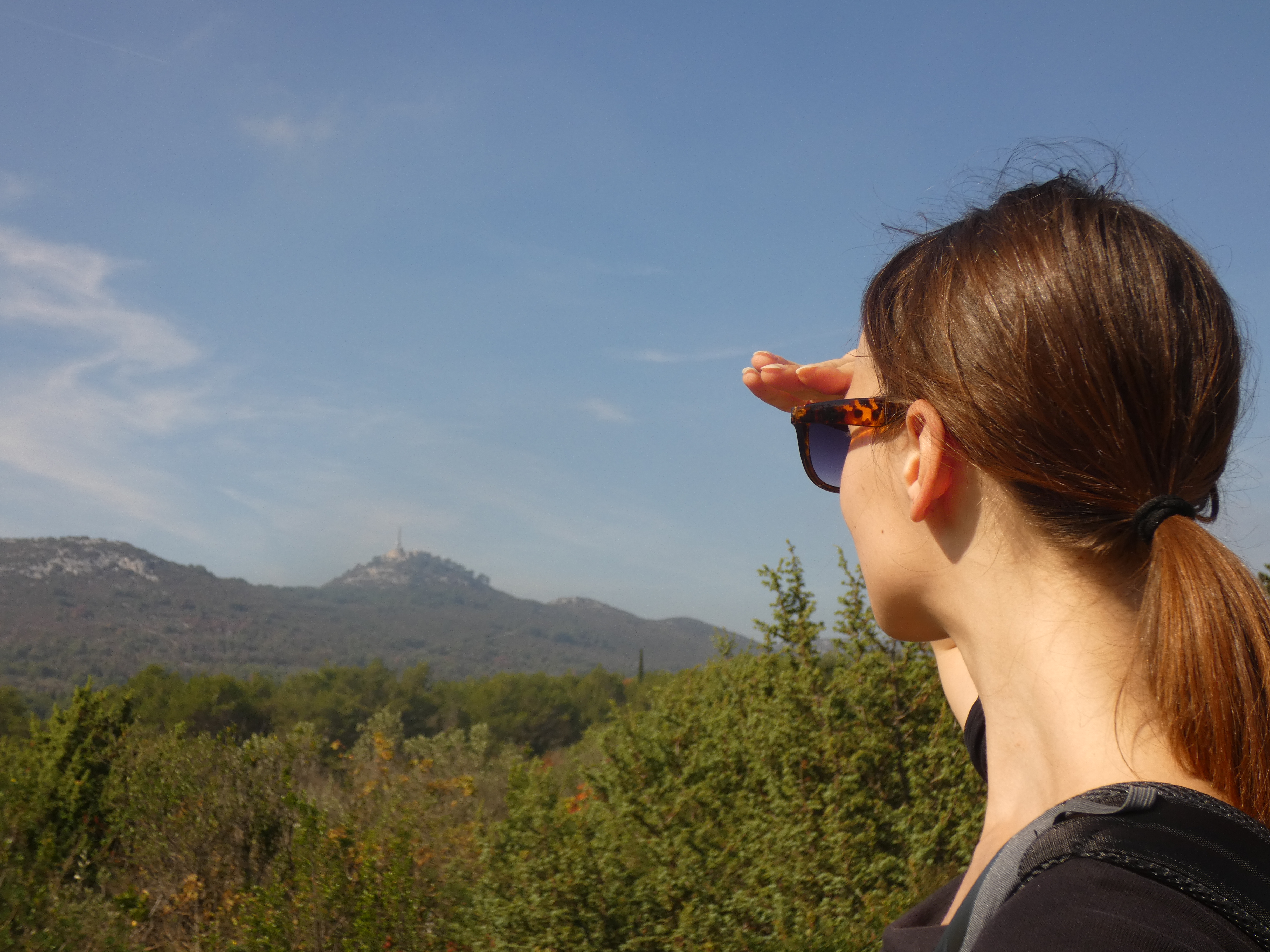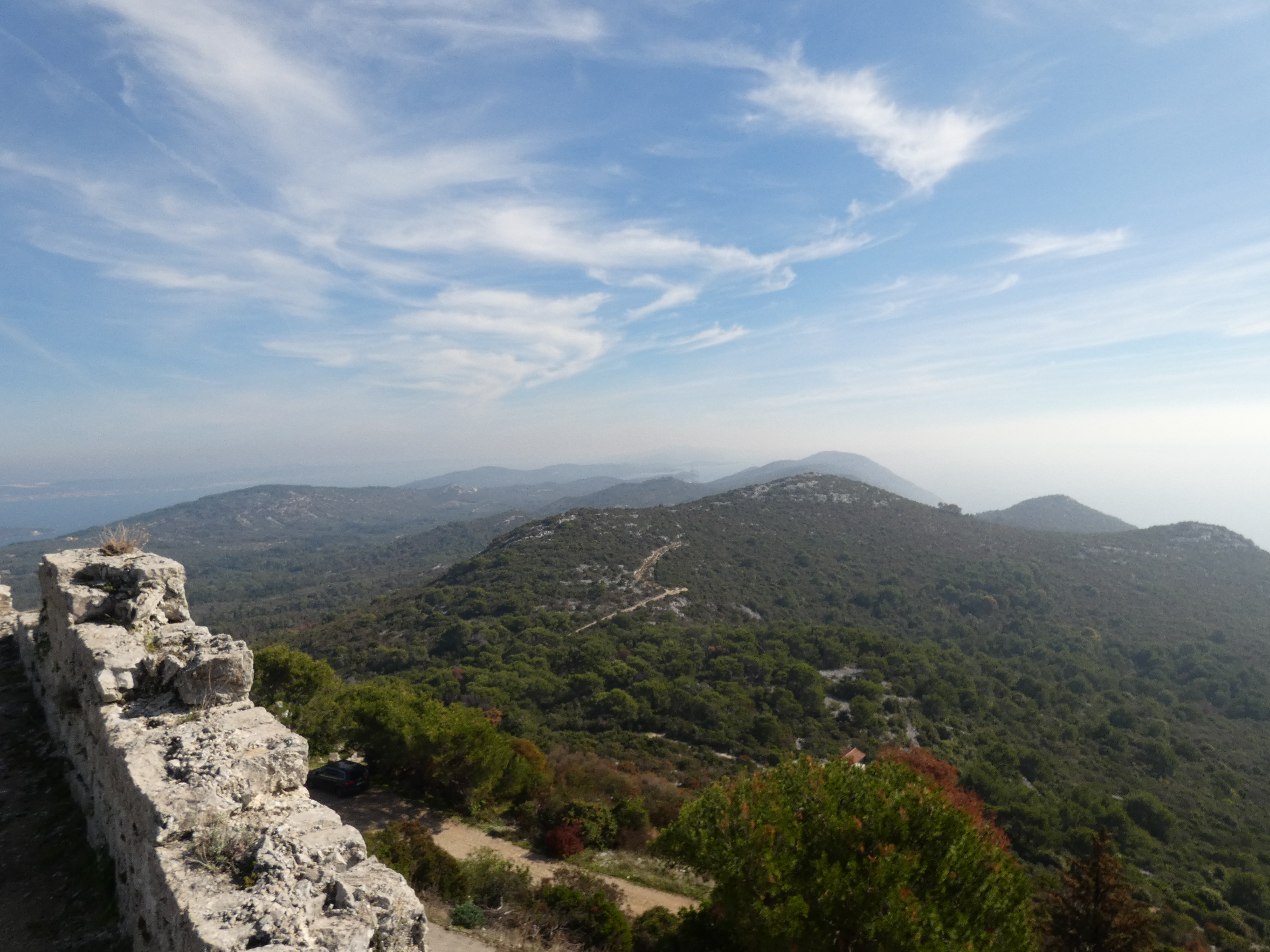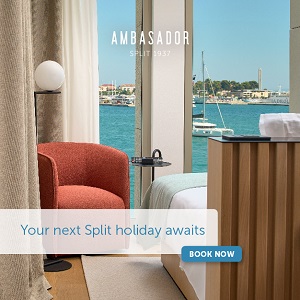Port of Ploče: Complete Reconstruction of Damaged Area Planned
Ploče port suffered an unexpected blow (quite literally) thanks to a large tanker this past summer, and now a full reconstruction is due to take place.
As Morski writes on the 25th of November, 2018, over the coming few days, the second phase of the reconstruction of the tanker connection should begin after the damage that took place back in August this year, following the incident in which the "STI POPLAR" tanker accidentally struck the concrete, which resulted in the complete discontinuance of oil derivatives and other products via the otherwise significant port of Ploče.
Following some temporary repairs, the first tanker, named "SEPEN" carrying 3,500 m3 of oil derivates sailed into the port of Ploče three weeks ago.
The Ploče Port Authority, which deals with and takes care of the port's infrastructure as a whole, immediately took all of the many necessary steps to repair the damage as soon as possible and re-establish the traffic of the current cargo load through the Port of Ploče following the unwelcome incident.
In regard to the required works, the Port Authority, along with the "POMGRAD INŽENJERING" d.o.o. construction company from Split, the total reconstruction of the platform, as well as the removal of the collapsed concrete has now been agreed, in a move which encompasses the first phase of reconstruction of the damaged areas. The first phase has been successfully completed within the desired deadline, and the value of the completed works stands at about 4.6 million kuna, according to a statement on the matter from the Ploče Port Authority.
After the public procurement procedure is signed and the construction contract is signed, the Ploče Port Authority should begin with yet another phase of reconstruction of the damaged tanker connection, which implies the construction of completely new mooring area.
Estimates suggest that the works on the construction of the new area will last approximately 100 days and the value of the works will be estimated at approximately six million kuna.
For the period lasting until the complete reconstruction of the tanker connection, a temporary regime of sailing with the "Vlaška" channel was established, which implied certain unwanted limitations in terms of vessel size, as well as additional safety measures.
Make sure to stay up to date with our news page for more information on the latest important construction projects in Croatia.
Ugljan's Saint Michael – a Fortress That Withstands the Test of Time
Heritage often tells us interesting stories, not only from the past, but also from the present.
Along with their role in historical events, heritage sites have an effect on the local populace and their day-to-day lives. Future articles will attempt to revive an interest in heritage and bring it closer to readers. To start it all off, let’s talk about Ugljan's Saint Michael.
If you happen find yourself on the Zadar waterfront (famous for its Sea Organ) during a clear day, your eyes might catch a glimpse of some hills off in the distance, on the island of Ugljan. Upon one of these hills, you’ll find the fortress of St. Michael. After a short ferry trip from the Zadar, you’ll spend some two hours hiking along the road, asphalted for most of the way. Following the path across the valley, surrounded by olives and dry stone walls, you will eventually arrive at the fortress.
Step by step, we’re getting closer to the fortress.
Views such as these of the Zadar archipelago, hinterland and the mountain Velebit are a reward in and of themselves after the hiking trip. Make sure to go on clear day to actually catch these views yourself.
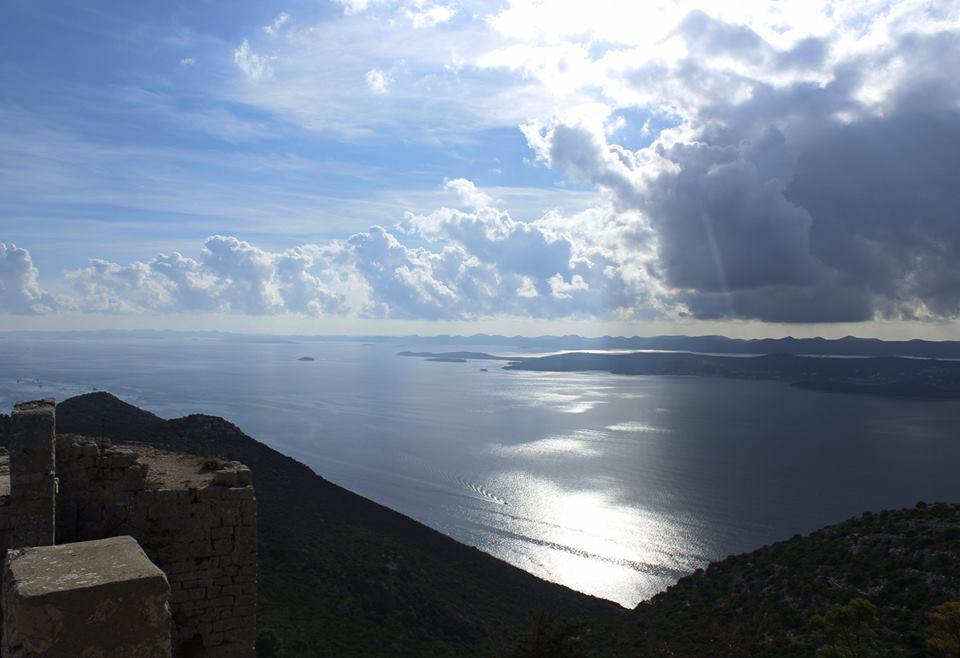

Then again, the buzzing from the radio antenna right behind you, in the fort, is almost enough to spoil these idyllic scenes...

The antenna has been here for 27 years. At long last, the local government has decided to move it to a neighboring hill. If everything goes according to plan, the antenna should be removed by the end of next year. The fortress of St. Michael dates back to 6th century A.D., when it most likely served the role of an observation post. During this same period, Byzantine Emperor Justinian the Great had been making attempts to revive the western half of the once mighty Roman Empire.
With its strategic position at an altitude of 265 meters above sea level, it’s possible that the fort was used by the Byzantine Empire to monitor and control the surrounding sea routes.

The exact year or timeframe in which the fortress was built is still unknown. There are, however, traces and evidence of the Order of Saint Benedict being situated on this hill in the 11th century. The first records and mentions of the fortress date back to 1345, when it was besieged and conquered by the Venetians. In the following years, Venice had plans to destroy the fortress – they did not want the fortress to fall back under Zadar’s control should they ever need to retreat from it.

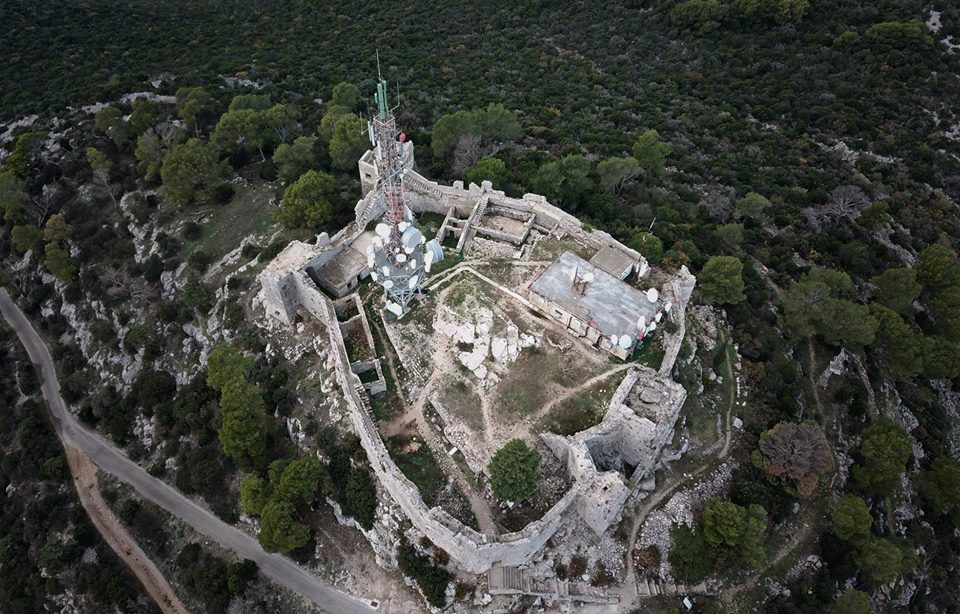
Layout and drone photo (Luka Bogdanić)
However, with the Treaty of Zadar in 1358, which was arranged between Venice and Louis I. of Hungary, the Venetians surrendered and retreated from their all of their Dalmatian territories. The fortress of St. Michael was now once again in the hands of Zadar.
The constant looming threat from Venice made Zadar officials invest a lot of funds, manpower, and effort in repairs and additional construction for defense and soldiers. There is a lot of textual evidence about the exact construction work and some of it is attested on site.
History is anything but boring and predictable in these parts, though. All the repairs and construction ended up being in vain because of Ladislaus of Naples. He decided to sell Dalmatia to Venice in 1409. Without any actual fighting to speak of, the fortress had once again fallen under Venice’s influence. Not to mention in much better shape than it had been in 60-70 years prior.
In the following years, it was used as a scouting post without proper maintenance. How it looked like is very well depicted on the painting below, made by pilgrim Conrad Grunenberg (1486).

The Fortress of St. Michael is in the foreground, while behind it you can see medieval Zadar.
Later on, during the Austro-Hungarian Empire and Kingdom of Yugoslavia, the fortress maintained its status as a scouting post. It wasn't repaired or properly maintained.
Later yet, the fortress played another role in history – in World War Two. In 1944, the fortress was still being used as an observation post. On August 29th and September 10th, Saint Michael was bombarded by the South African Air Force (16th Squadron). Planes started their flight from Biferno in Italy. As they flew over Saint Michael, high resolution cameras documented the damage they had made. Thanks to Tinus la Roux – a South African enthusiast collecting documents and memories of WW2 veterans – we now have records of these very moments of the fortress being bombarded.
The church in the middle was destroyed, and one of the main towers was severely damaged.

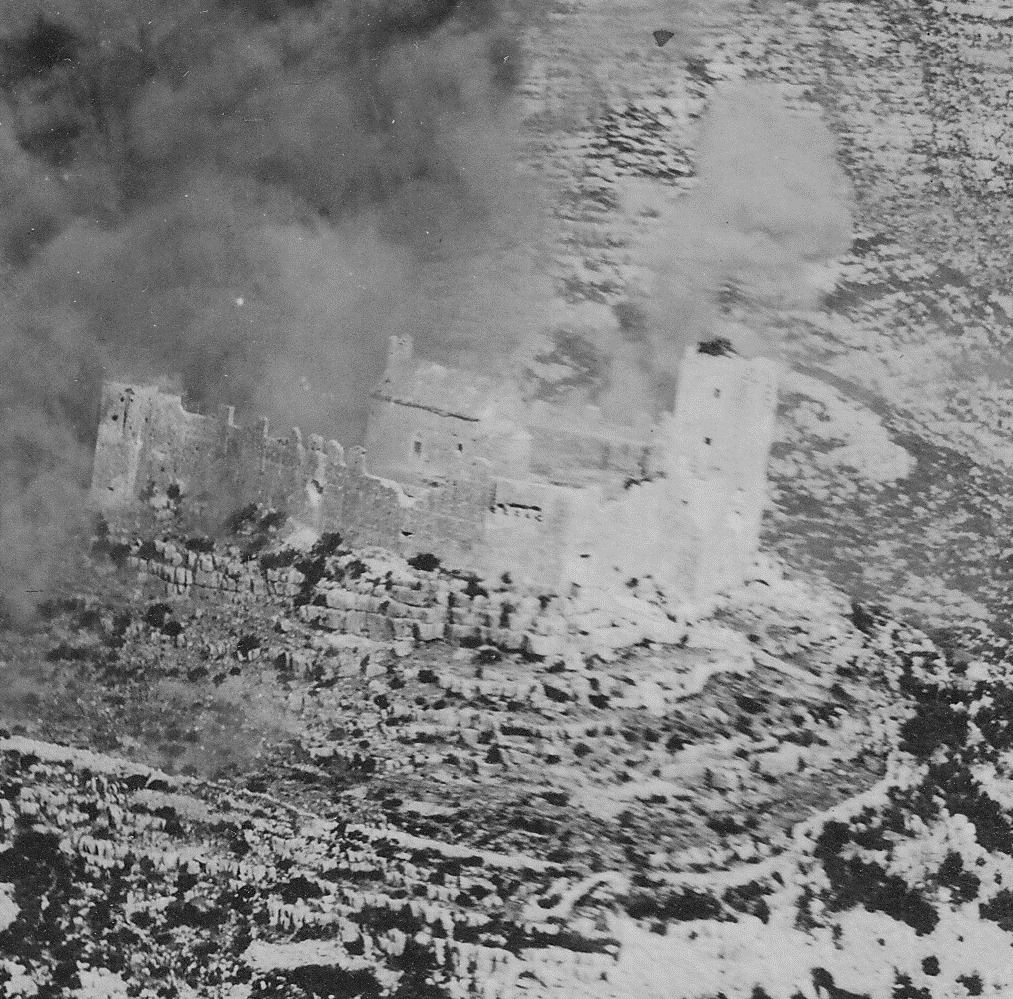
Notice the church, still intact at this point, in the middle of the fortress.
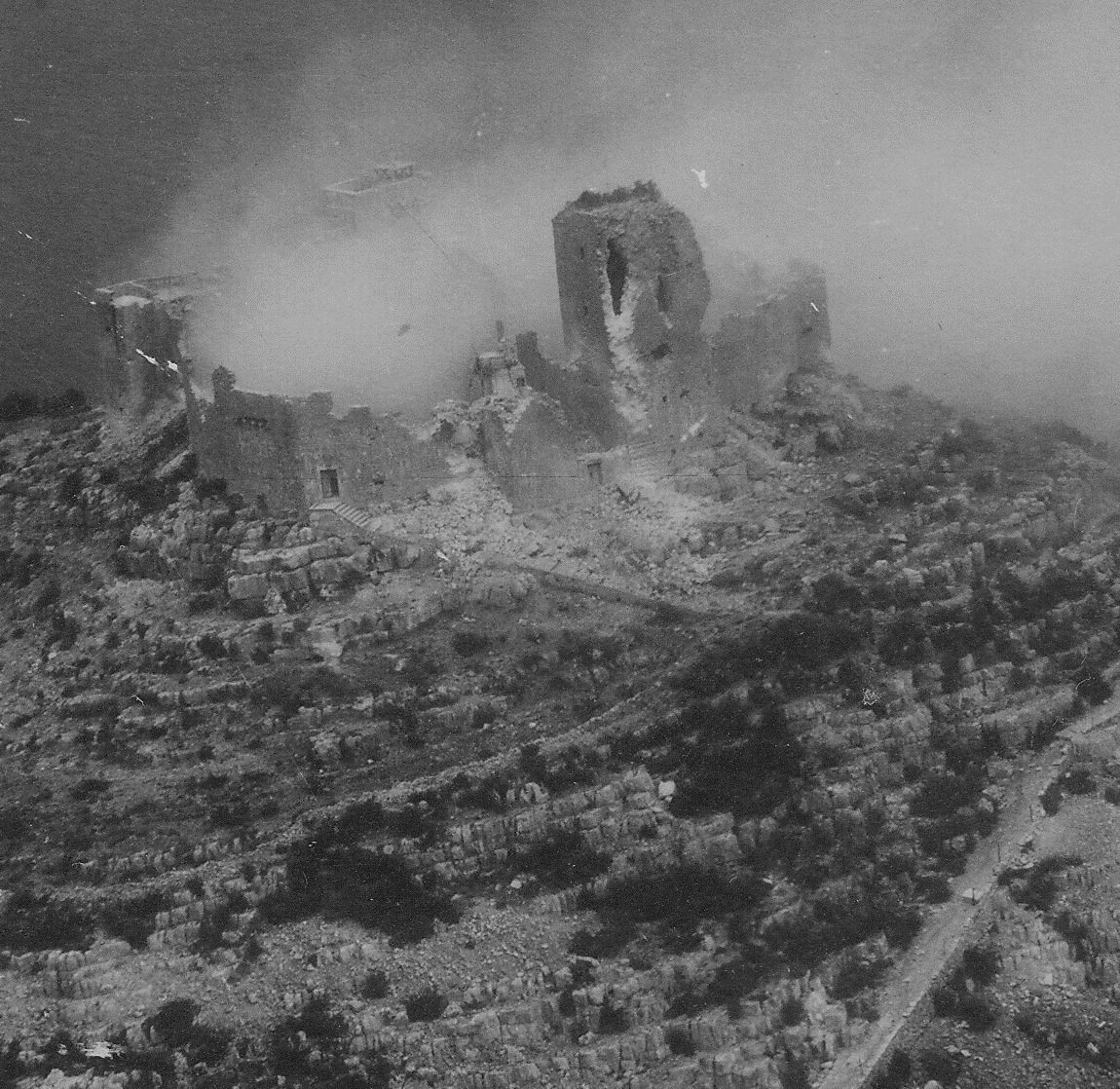
For more photos and documents of the bombardment, click here.
Nowadays, the fortress is still in bad shape. There is no trace of the church, the towers and the walls weep for reconstruction, and recent construction work doesn't paint any brighter of a picture.
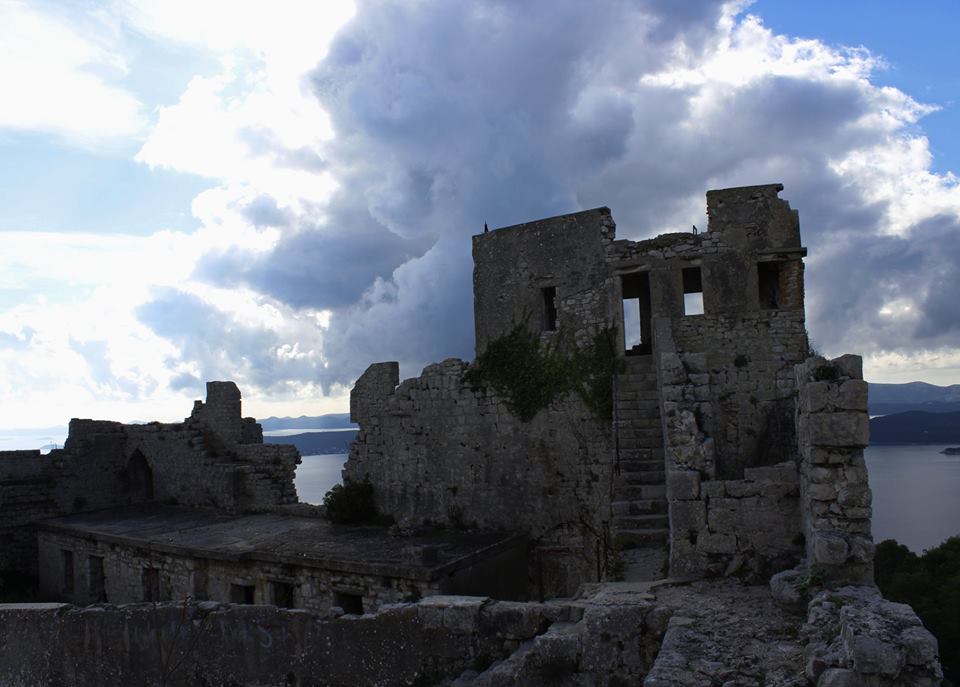
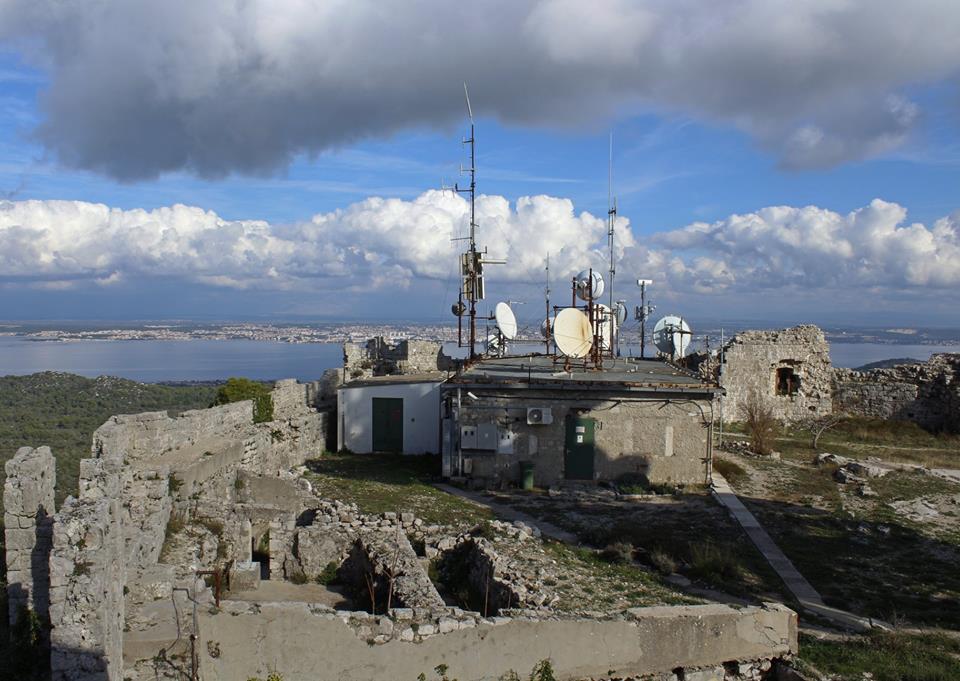
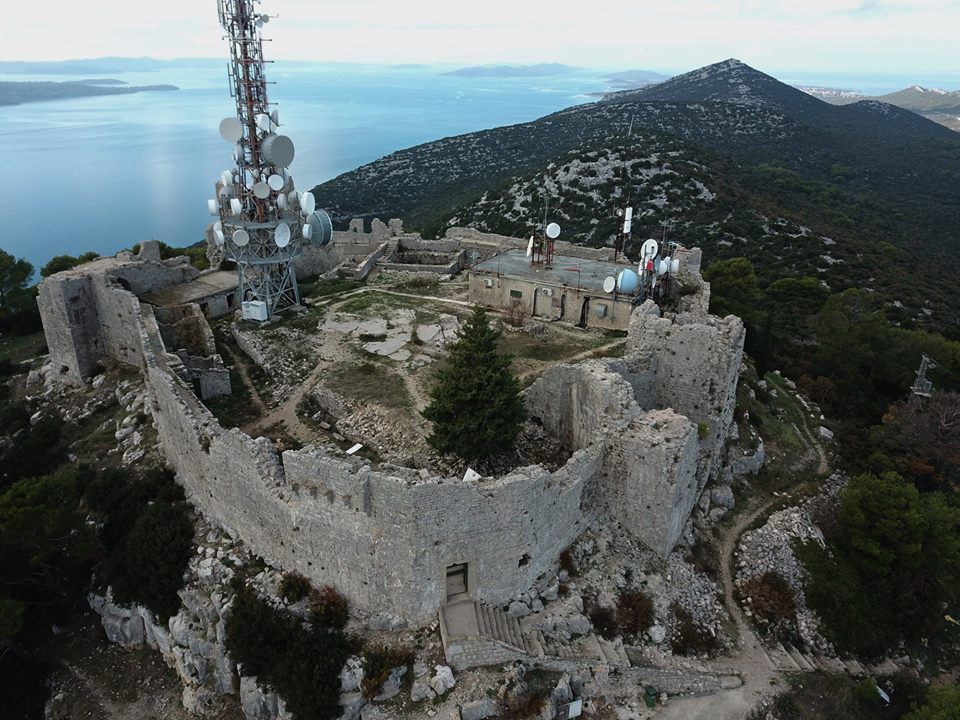
Drone photo by Luka Bogdanić
There are plans and visions for the fort’s future, according to the Tourism Municipal Board of Preko. Some picture the fortress of Saint Michael becoming interpretative center called “The Castle of Island Stories (Dvorac otočnih priča)” – telling the stories of all nearby islands with an actual overlook holds a lot of potential. Some additional objects, like an open-air amphitheater, a souvenir shop, and others, would also be a part of this center.
For now, this is still nothing more than a nascent idea. Archaeological excavations and conservation work will take place before anything else. We never know what the ground is hiding, after all, so we might find out something new about this place.
In the meantime, it will remain a favourite place for a quick escape from the bustling city.

Drone photo by Luka Bogdanić
If you’d like to see more photos, or behind the scenes/research moments of Croatia's wealth of heritage, feel free to follow us on our Instagram account, Culture Donkey.
Make sure to follow our lifestyle page for more information on Croatian history, heritage, and significant monuments, fortresses, and much more.
ECO-NautiNET: Platform Designed for the Nautical Sector
As Morski writes on the 24th of November, 2018, a meeting of the technical working group in the framework of the ECO-NautiNET web project was held in Dubrovnik on November the 20th and 21st, in which the needs of the website's users were discussed. Through the ECO-NautiNET project, activities are being carried out to improve the competitiveness and innovation of small and medium-sized companies in the nautical sector, as well as acting as a means to support their internationalisation and networking abilities.
The meeting saw the presentation of the results of the research conducted so far between the four target groups - the small and medium-sized companies from within nautical sector, broker project partners, and supporting institutions and scientific institutions. Based on the results and conversations with platform developers, the technical working group has managed to define the simplest in which way to include future users, and which tools are needed for the most efficient presentation of the project's products and services, technical and technological achievements, and innovations.
The goal of the ECO-NautiNET web platform is to motivate and involve as many business entities, support institutions, and other innovations in order to take advantage of the opportunity to place themselves on new markets, and to develop the competitiveness and innovation of the nautical sector of the Adriatic-Ionian region as a whole, through easy access to all news and high quality information in just one place.
This goal is highlighted as the desire to become the most important development driver of contact with more than 500 businessmen from the nautical sector from across Croatia, Albania, Italy, Greece and Slovenia, and most entrepreneurs in this field continue to face the same or very similar problems irrespective of the country they come from.
As a result, most of these companies have up to ten employees, and as far as typical issues and problems are concerned, poor cooperation within the nautical sector, a lack of clear nautical sector development policy, and the fact that cooperation with research and science centres is either non-existent or very small stand out as the most common and indeed the most pressing.
Over 80 percent of the respondents are primarily interested in improving competitiveness and innovation by linking small and medium-sized entrepreneurs in the Adriatic-Ionian region's nautical sector with supporting institutions and research and scientific centres through the ECO-NautiNET web platform.
ECO-NautiNET is otherwise project number 398 which is part of the INTERREG ADRION transnational cooperation program co-financed by the European Regional Development Fund (ERDF) and IPA funds (IPA II).
Make sure to stay up to date with all things sailing by following Total Croatia Sailing and our dedicated lifestyle page.
Click here for the original article by Jasna Jaklin Majetic on Morski
Šibenik Company With Distinguished Clientele Raises Business to Higher Level
The Šibenik company, Capax, currently employs twenty people and, as they themselves have pointed out, are constantly looking for new, quality members of staff.
As Darko Bicak/Poslovni Dnevnik writes on the 24th of November, 2018, after a successful September when they presented themselves as the only Croatian exhibitor at the prestigious Monaco Yacht Show, as well as managing to win the Golden Kuna (Zlatna Kuna) award for the best small company in Šibenik-Knin County, Capax opened its new headquarters in the historic Dalmatian city of Šibenik at the end of October this year.
Covering an area of 900 square metres and in addition to the brand new office, located at the new facility is a spacious service workshop and the only laboratory designed for engine oil analysis in the wider area. Capax already offers videocopy services, ultrasonic measurements, vibration analysis and thermography, but only now with the engine oil analysis specialist lab services has the Šibenik company managed to raise itself to yet another higher level. All these services will also open up new markets such as those which involve dealing with work boats, construction machinery, locomotives, windmills, and more.
While this is a Šibenik company, renovation works are carried out in nearby Trogir, within the Trogir Service Centre (SCT), with which Adria Docks has recently been established. Adria Docks manages renovations, optimises work processes, and ultimately controls the quality of the outsourced works. Within the framework of a long-term joint venture with the Trogir shipyard, in an area of about 250 square metres in the SCT area, lies the second part of Capax's investment, a test station for ship and industrial engines of up to 3.4 megawatts.
The total value of the investment is more than 15 million kuna, of which 5.5 million kuna are non-refundable funds from the European Structural Funds indended for the building of production capacities and the investment in equipment.
"Access to the client, respect for their demands and a true effort to achieve goals through project and refit management have inspired us as the leaders of the domestic yachting industry. We have well equipped and educated service teams for the most common types of marine engines, clutches and generators we find on larger yachts and on mega yachts. Our service engineers are ready to solve every problem, whether it's mechanical, or electrical, or something else,'' they state from Capax.
They add that for subcontractors, whenever possible, they use the services of other Croatian companies and hope that their success will stimulate other companies from the Croatian nautical sector to invest and develop themselves more. Capax was initially founded by three like-minded people, Mario Baljkas, Teo Petričević and Željko Tesi. As previously mentioned, they currently employ twenty people and are constantly on the look out for new, high quality staff. The company continues to record steady and stable revenue growth, and last year, those figures amounted to about 30 million kuna.
The clients of this Šibenik company are typically the owners of yachts, or the management bodies of yachts, as well as insurance companies and shipyards and marinas. They specialise in technical engineering, consulting and supervision in shipbuilding, diagnostics, servicing, and the repair of marine engines, their maintenance and inspection in terms of value assurance for insurance purposes, as well as for sellers and/or new owners.
They are the authorised servicing body of some of the most prominent marine engines in this segment of the market, including Caterpillar, MTU, John Deere, and ZF, in addition to Šibenik, they also have offices in neighbouring Montenegro and in Albania.
Otherwise, this year, Capax was the first Croatian company to appear at the Monaco Yacht Show after four years in early autumn. they were one of the 580 exhibitors from 38 countries around the world.
"We're very pleased with the effect of participating in the fair and we believe that it will bring us more ships to service and overhaul to Croatia, and we wish to encourage other domestic companies to join us in the coming years,'' Petričević said.
Make sure to stay up to date with our dedicated business and Made in Croatia pages for more.
Click here for the original article by Darko Bicak for Poslovni Dnevnik
Gari Cappelli Praises Residents and City of Zadar
The City of Zadar has always been a popular destination in Dalmatia, boasting the stunning sea organ, and, as Alfred Hitchcock himself once said, the most beautiful sunsets in the entire world. Now Gari Cappelli, the Minister of Tourism, has congratulated this ancient city on its success, stating that the very people of Zadar are the ones who give it its life.
As tourists flock to Zadar from all corners of the world, with numerous airline companies having taken it upon themselves to either increase their flights to this Dalmatian gem or to introduce new lines connecting major European cities to its thriving airport, the city goes from strength to strength across the spectrum, from its entrepreneur success stories to its tourism figures. It seems that Zadar's success hasn't gone unnoticed, at least not by Gari Cappelli, who expressed his warm feelings for both the city and for the ''happy people'' who live there and make it what it is.
As eZadar/Radio Zadar writes on the 23rd of November, 2018, upon welcoming the participants of the session of the Zadar City Council on the occasion of Zadar's city day, Gari Cappelli, the long standing Croatian Minister of Tourism, stated at the beginning of his address, among other things, that Zadar is a city full of of happy people who give it life.
Gari Cappelli recalled the very welcome fact that the highly respected Lonely Planet, one of the most popular and trusted travel guides in the entire world, included Zadar in its announcement of the prestigious ''Best in Travel 2019'' guide, in its recommendations on destinations which should be visited by tourists next year.
Make sure to stay up to date with news from Zadar and far beyond by keeping up with our dedicated lifestyle and travel pages.
Vrgorac Mayor Dismisses Excess Administration, Turns Offices into Nursery
People are constantly complaining about politicians. It's a trend which knows no borders and isn't limited to any one particular place or nationality, but Croatia could quite easily win an Olympic medal in it if it was turned into a professional sport. The Vrgorac mayor however, will likely win a huge amount of praise for his latest unusual but righteous move.
While many politicians, mayors, deputy mayors (the list goes, and on, then on a bit more) continue to work in a ''politically cluttered'' city administration environment, where there are a huge number of people working and nobody really knows what they're actually doing, the Vrgorac mayor has decided on a somewhat different approach.
As Poslovni Dnevnik writes on the 21st of November, 2018, the Vrgorac mayor, Ante Pranić, has decided to dismiss Vrgorac's excess administration and turn their offices into a nursery.
''We don't have an administration now, because of rationalisation, but we do have a professional set of staff for kids,'' the mayor wrote on Facebook.
Vrgorac mayor Ante Pranić took to social media to let everyone know about the brand new, additional room for another group of children located on the premises where Vrgorac's administration was once.
''When the citizens put their trust in us, chaos awaited us in the kindergartens. We didn't have a pedagogue or the professional personnel, but what we did have was a surplus of administration. We've put that in order. Now we don't have an administration, because of rationalisation, but we do have a professional set of staff for the kids.''
Pranić went on to write that he was accused of having dismissed Vrgorac's excess administration illegally. He said that today, the court verdict in regard to that had arrived and it turns out that nothing about it was illegal.
''The court says we've all done it by law,'' Pranić wrote on Facebook.
Stay up to date with the strange world of Croatian politics by following our dedicated page.
Knin Gets First Panoramic Camera from Šibenik Meteo
Something new for the Dalmatian hinterland's famous City of Knin as the Šibenik meteo team place the area's very first panoramic camera with a stunning view over the city and the surrounding area, as well as of the Dinara mountain, located on the border of Croatia and neighbouring Bosnia and Herzegovina.
As SibenikIN writes on the 18th of November, 2018, the Šibenik meteo team set up Knin's brand new panoramic camera at a high location with an excellent view, on Knin Fortress, offering a stunning view of the historic Croatian city and its dramatic and rugged surrounding area which is typical of the Dalmatian hinterland.
As the title suggests, this is the first such camera in Knin, which, in addition to offering those who view it online an image of the City of Knin that alternates every five minutes, also allows for live streaming, and everything can be tracked directly via this link.
''This demanding project was brought to realisation in cooperation with the city administration which provided the location and the necessary approvals, as well as the financial assistance of the Krka National Park, Šibenik-Knin County, and the Adris Foundation,'' they state from Šibenik meteo.
The Šibenik meteo team have also announced that they plan to install a modern automatic weather station in the area belonging to of a local school (Osnovna škola Domovinske zahvalnosti), which will, in addition to the city's brand new camera, send real-time data to the Internet, and the same will be implemented in regard to the panoramic camera as well.
To keep up with more information like this, from Knin, the Dalmatian hinterland and far beyond, make sure to stay up to date with our dedicated lifestyle page.
NP Mljet Celebrates 58th Birthday with Events in Zagreb and on Mljet
Ever been to NP Mljet? Lying not far from Croatia's southernmost city of Dubrovnik, Mljet national park, otherwise Croatia's most heavily forested island and unarguably among the most unusual, is a must visit place for those wanting a sense of peace. Photographers and nature lovers alike are also attracted in their droves to beautiful Mljet.
As Morski writes on the 11th of November, 2018, NP Mljet, the Republic of Croatia's and the Mediterranean's first properly protected marine area, is celebrating ts 58th birthday today! Established on this day back in 1960, NP Mljet has naturally become the target of numerous visitors from across the world who want to experience some of the Adriatic's pure and rich nature. This year also stands out as a record year for the number of visitors to NP Mljet.
In addition to a huge number of visitors, this year is also significant thanks to the arrival of the first of three electric catamarans for the transportation of visitors to NP Mljet's Great lake, and the signing of the Grant Agreement for a project for Mljet worth a massive 36,618,480,26 kuna. These resources will improve and enhance the popular national park's visitor infrastructure, and enrich the quality and quantity of touristic, educational and recreational content on the island.
The birthday celebrations of NP Mljet began back on October the 22nd with the opening of an exhibition of photographs in the Gallery of the Archaeological Museum in Zagreb. In addition to the exhibition, from October the 24th to the 31st, the Days of Open Doors and a special program for the visiting of NP Mljet for the passengers of the Krilo Star catamaran's final journey for 2018 were held. The celebrations will continue through November when an exhibition on the cultural heritage of NP Mljet opens far from Zagreb, on the island of Mljet itself, all on the occasion of the International Year of Cultural Heritage.
Happy birthday, Mljet National Park!
Want to keep up with more news on Croatia's many national parks and islands? Make sure to follow our lifestyle and travel pages for more.
Investment in Tourism: Cash Injection for Dubrovnik's Hotel Bellevue
Investment in tourism is a machine boasting many wheels which must keep turning and following world tourism trends on a constant basis.
Stagnation in the tourism sector has been threatening Croatia following a few record tourism years, and while many expected such a drop as more of the country's older tourism rivals recover respectively, just how can Croatian hotels keep their rooms full and their offer hot in the face of strong competition from long-time tourism kings like Spain and nearby Greece?
As Poslovni Dnevnik writes on the 6th of November, 2018, over the now rapidly approaching winter period, the well-respected Adriatic Luxury Hotels hotel group will continue its massive investment cycle and focus on properly restoring and redoing some of their highest category hotels located in one of the country's most popular tourist destinations, southern Dalmatia's Dubrovnik area.
After the luxurious ''doing up'' of two top Dubrovnik hotels, Hotel Kompas (Lapad) and Hotel Excelsior (Sveti Jakov area), Adriatic Luxury Hotels have announced that the same will be done to another of their high-end hotels, Hotel Bellevue, which closed its doors to guests on October the 31st this year, in order to prepare for the huge renovation works of the hotel's accommodation facilities and part of the hotel's interior which are due to begin during the winter.
Adriatic Luxury Hotels will invest more than 400,000 kuna per room in the upcoming complete re-doing of the top hotel's rooms and apartments, representing the first significant investment in Hotel Bellevue since its inauguration over a decade ago, back in 2006.
The Portuguese design studio Tereza Prego is heavily engaged in the project, specialising in the interior design of exclusive hotels and other high-end residences.
As things currently stand, it seems that the redesigned Hotel Bellevue will be ready by the spring of 2019.
Click here to see just how the hotel will look upon opening its doors early next year.
Want to keep up to date with Croatia's investment in tourism and see if any hotels in an area you're planning to stay in are about to undergo makeovers? Make sure to follow our business page.
Beach Cleanup: NP Mljet Puts Environment First
Keeping on top of things and putting the environment first isn't always easy in the time in which we currently live, but a beach cleanup is a more than excellent way to start. In Croatia, such seabed and beach cleanup actions take place quite regularly up and down the coast, with the most emphasis being placed on the pre and post season.
During this somewhat turbulent time of year, it's typical for unstable weather conditions and strong winds and currents to wreak havoc to some degree or another, often bringing in unwanted rubbish from other parts of the coast, sometimes even dragging up piles of waste on currents from Albania to Dubrovnik.
Plastic pollution is an increasingly dangerous threat to the world's seas and oceans, and while various laws continue to be passed to either ban or at least limit the use of ''throw away'' plastic products, the issue remains a pressing one. A well organised beach cleanup is an excellent way to combat the problem.
As Morski writes on the 1st of November, 2018, beautiful Mljet has experienced a proverbial reincarnation this year, as 32 volunteers participated in a program to clean up as many as fifteen bays and coves on Mljet, which is otherwise one of the country's most breathtaking national parks, located not too far from Dubrovnik.
This year's volunteer program, developed by JUNP Mljet and the Ministry of Environmental Protection and Energy through the EU Integration Project Natura 2000, was successfully completed, with 71 volunteers participating in all of the four volunteer programs.
For the first time, NP Mljet welcomed international volunteers from Lithuania, Australia, America, and neighbouring Montenegro and Bosnia and Herzegovina to help clean up the national park's many bays and coves. Over 400 plastic bags, sewage, glass and various other types of waste was successfully removed from Mljet's shoreline.
Want to keep up with more news about how the environment is taken care of in Croatia and how you might be able to help? Make sure to follow Total Eco Croatia.

